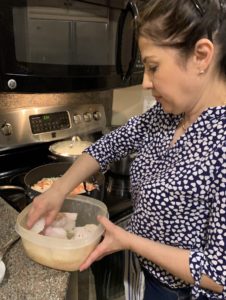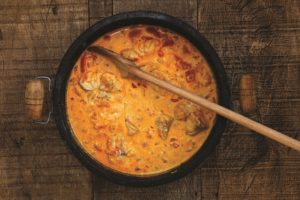“Don’t worry,” said Nete Balbino the first time we met. I was frazzled, trying to organize the move that would settle Christopher and me in a new cottage as Truro year-rounders. Nete was there with her crew to help us get things fit for habitation. She was confident. “We’ll take care of everything,” she said.

I should have known that she had been a chef.
Over the next few years, I learned that she’s from the town of Nova Aurora in the southern Brazilian state of Paranà, that she has a daughter on the Cape and a son in Brazil, and that she was determined to get American citizenship. Before immigrating, she owned a series of small restaurants in Brazil.
“You’re a chef!” I said when she told me this. “They were small restaurants,” she responded. I admitted knowing little about Brazilian cuisine. “Maybe someday you’ll teach me,” I said.
“Oh yes,” she smiled. “I will teach you.”
Last year, Nete returned to cooking professionally. I heard from her daughter, Julye, that she was happy to be in the kitchen again but also busy preparing for the final step in becoming a citizen — the Test. Still, Nete hadn’t forgotten about my hope, and we finally made a date.
At her home in Orleans on a Friday evening, we learn how to make moqueca, a foundational Brazilian seafood stew, beloved in its regional variations. We’re greeted by a houseful of people. Nete has her mis-en-place set up and, after a glass of wine, we begin to build the dish.
Vegetables are sautéed in red palm oil (azeite de dendê in Portuguese), which lends both floral and smoky notes and an orange hue to the dish. Coconut milk and stock are added, and Nete raises the bar on creaminess with crème de leite, a can of cream.
Towards the end, she adds the fish, which has been marinated in fresh lime juice, covers the stew, and lets it simmer for a few minutes. Typically, moqueca includes shrimp but Nete hasn’t added it because Douglas, Julye’s husband, is not fond of shrimp.
We carry the moqueca to the table. It’s a gorgeous deep orangey-pink, and its aroma is irresistible. Although the stew came together as easily as a weeknight supper, it is absolutely special enough for a celebration. White rice soaks up the creamy, spicy sauce. Fried bananas offer contrasting crispy textures. And a papaya salad cools some of the heat of the dish.
As we sit around the table savoring the moqueca, we tell stories. We hear of Nete’s long journey to the U.S., of Julye and Douglas giving up careers in Brazil to begin again on the Cape, and of the recent arrival of his parents.
There is an underlying optimism in these stories. That and the stew seem to reawaken my optimism, too. I am reminded of my own family’s story — my ancestors were refugees from British Canada who arrived in 1760 — and of how this country continues to be built on the hopefulness and hard work of people from so many different places.
Then we raise our glasses to Nete: chef, host, friend, and — because she has only just the day before passed the Test — new American.
Nete’s Moqueca
Serves 8

Use the freshest firm, white-fleshed fish at the market — cod, halibut, or striped bass. Rather than chicken or fish stock, make a quick shrimp stock with the shells of the shrimp; giving 4 cups of water, and some onion, carrot, celery, garlic, and wine 30 minutes at a low simmer works well. The red palm oil can be found at Gol Supermarket on Iyannough Road in Hyannis.
3 pounds of thick white fish fillets
2 pounds raw shrimp, peeled and deveined
½ cup dendê (red palm) oil
3 onions
1 each, red, yellow, and green pepper
1 fresh, hot chili, birds-eye or serrano
3 garlic cloves, minced
1 Tbsp. tomato paste
2 tsp. sweet paprika
1 tsp. ground cumin
1 cup chicken or fish stock (see note)
3 large tomatoes (or a 15 oz. can chopped tomatoes)
Zest of one lime
Juice of 4 limes
1¼ cups coconut milk
1 can crème de leite (optional)
2 cups cilantro leaves
1 bunch scallions
Salt and pepper to taste
Marinate the fish while you prep the rest. Zest one lime, then juice it and three more. Mix the lime zest, 3 tablespoons of the juice (save the rest for the end), and a teaspoon of salt in a large bowl. Cut the fish fillets into 2-inch pieces and add to the marinade, turning and massaging gently to cover the fish completely. Set aside.
Sliver the onions and cut the peppers into ¼-inch-wide slices. Seed and slice the chili pepper. Mince the garlic. Seed and chop the tomatoes. Chop the cilantro and scallions for the garnish.
In a large sauté pan that will hold all the ingredients without crowding, heat the dendê oil over medium high heat until is just shimmers. Add the onion and a half teaspoon salt and sauté until the onions are translucent, 3-4 minutes. Reduce heat to medium, add peppers, chili, and garlic, and cook another 5 minutes. Stir in tomato paste, spices, and stock. Add tomatoes and bring to a simmer. Reduce heat and cover, cooking for 10 minutes.
Add the coconut milk (and crème de leite, if using) and then taste for salt. Add the shrimp and cook uncovered 2 minutes. Then nestle the fish into the stew and simmer until cooked through, spooning the sauce over the seafood as it cooks, about 4-6 minutes. The dish may also be finished in a 350-degree oven. Before serving, taste again for salt. Drizzle on the remaining lime juice and scatter with chopped cilantro and scallions.



